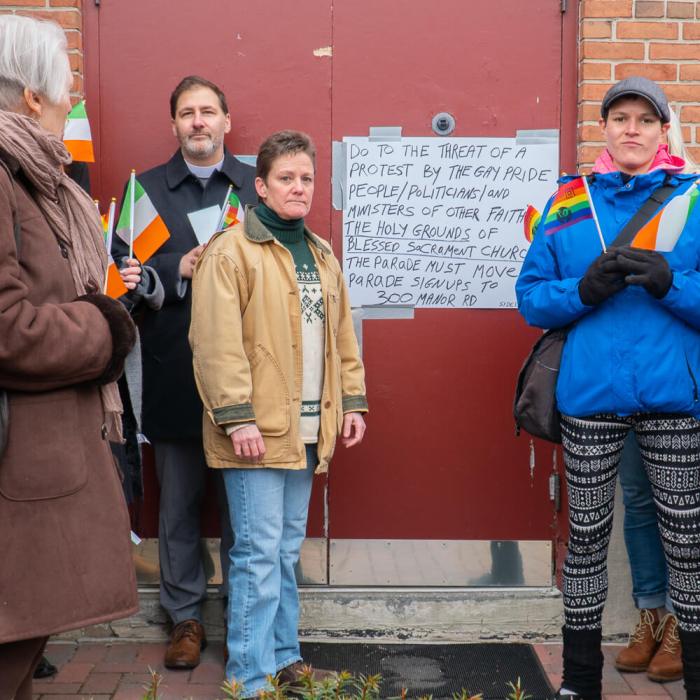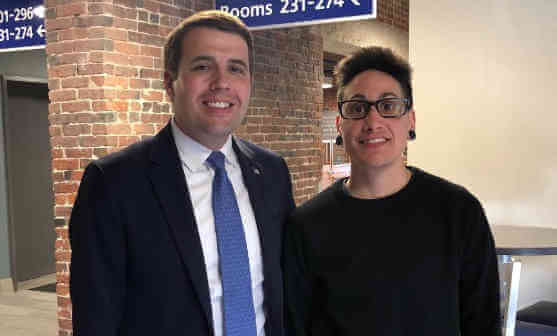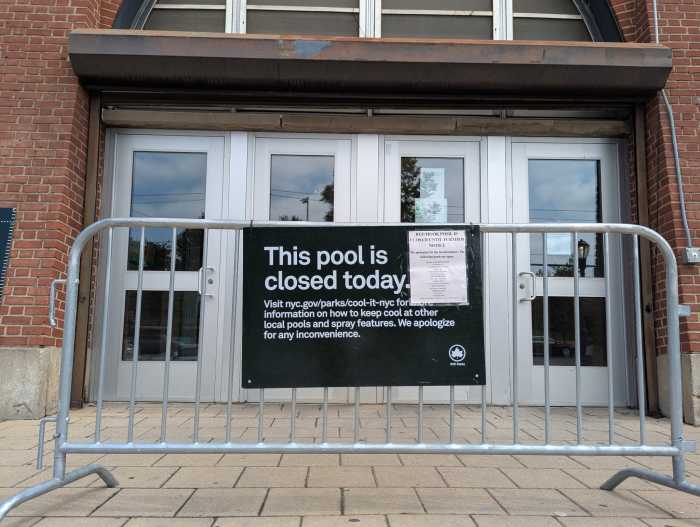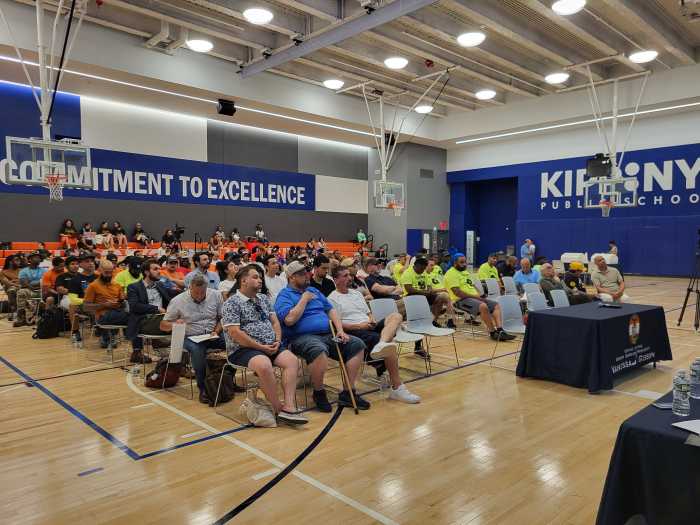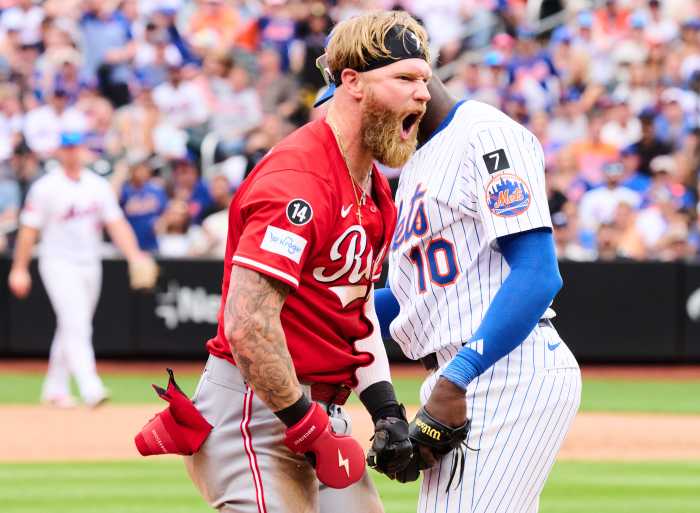Crowds gathered near the West Building of the National Gallery of Art for the rally that preceded the massive march. | DONNA ACETO
Women with their babies cradled in wraps, women with toddlers, pregnant women, mothers with their teen and adult daughters, women of color and of sexual diversity, females from a few months old to over 80, concerned gay and straight men — cisgender and transgender — fathers, husbands, brothers, sons, citizens from across the country stood shoulder to shoulder with barely inches of air between them, and everyone was smiling.
This was the January 21 Women’s March on Washington, a sea of some 500,000, many wearing homemade pink pussyhats as commentary on President Donald Trump’s recorded comments that he could grab a woman’s genitals whenever he may choose. Creative signs, also mostly homemade, shouted out support of equal rights for all and dismay at the bigotry, misogyny, and crudeness of the new president.
Women’s issues formed the basis for an organizing effort that broadened quickly. | DONNA ACETO
“This Is Only The Beginning,” was the sign Kristen Rogers wore as she directed crowds as part of the organizing crew. An attorney, she traveled from California because she felt that “it’s more important than ever that people band together and truly participate in our democratic process. What we’ve seen in the discourse of this past election cycle needs to be addressed head-on consistently in the next four years.”
She added, “In two years we have midterm elections and it’s critical that we have incredible turnout among Democrats and progressives so we can affect the redistricting cycle.”
The DC march was the heart of a worldwide swell of Women’s Marches Saturday that drew an estimated three million people. In her speech from the podium, longtime feminist leader Gloria Steinem said that 370 such gatherings were taking place in every state and on six continents.
On a bus from New York City the day before the March, women explained their dedication and drive. Anne Beaty, from Connecticut, unfolded a banner that read: “Nasty Women Revolt” and said she was meeting a friend traveling from Paris.
Alex Trinkoff, from Long Island, and her daughter Kyra Shor, who lives in Brooklyn, both Smith College graduates from different eras, have long shared feminist views.
“I have felt extremely vulnerable since the election,” said Shor. “I’m sick of feeling not valued. I want my voice to be heard. My mother has been taking me to feminist rallies since I was a baby. It feels as if things have gotten worse.”
Trinkoff made clear, “I’m walking for my daughter. What I say and what I do matters. We have to stand against rhetoric that incites violence and promote the love quotient.”
Support for LGBTQ rights was another prominent part of the march. | DONNA ACETO
Despite a chilly, gray mist, the mood of the marchers was sunny. Ann Grant, a public defender from Massachusetts with her seven-month-old daughter Vivian wrapped tightly to her chest, said of her child, “It’s important that she start her civic duty early. This presidency is going to require a lot of dissent and a lot of action by the people to demonstrate that they don’t approve of his creeping autocracy.”
Grant held a sign that read: “There’s More To Protest Than I Can Fit On My Sign.”
Also in the crowd, a group of five activists, several from the group Women of Green, who had driven 1,800 miles from New Mexico. Their sign encouraged everyone to “Meditate, Listen, Organize, Dance, and Make America Beautiful Again.”
The Women’s March has the potential to open up a new phase of activism among a broad swath of Americans. | DONNA ACETO
Tess Young, a dancer, personal trainer, and member of the New Mexico contingent, said that she was “born and raised in Korea, so I know when you have a country with a bad leader, the country is really in trouble. I’m here to participate.”
Greg Newcomb, who works in advertising and graphic design and lives in DC with his husband, explained, “We’re a gay couple. We believe in human rights. We are supporters of equality for everyone. We have a lot of women in our lives, strong, powerful women that we are here to support. I’ve said to friends, ‘I came out of a vagina so I believe in supporting those who gave us life.’”
Young marchers included Accalia Frey, a 17-year-old freshman at Hofstra University, who worked behind the scenes at the presidential debate between Hillary Clinton and Donald Trump at the Long Island college.
“I’m not really happy with this president so I wanted to be able to come here and express my views,” she said.
Many men showed their support for feminist issues. | DONNA ACETO
Even younger was six-year-old Sophie Cruz, accompanied by her undocumented parents, who offered a heart-melting speech from the stage.
“Let us fight with love, faith, and courage so that our families will not be destroyed,” she said, “I also want to tell the children not to be afraid, because we are not alone. There are still many people that have their hearts filled with love.”
Sophie spoke in English, then repeated the same words in Spanish, and ultimately led a call to action that filled the air with hundreds of thousands of voices: “Si se puede!” or “Yes we can!”
A marcher grabs a selfie with feminist icon Gloria Steinem. | DONNA ACETO
The stage welcomed more than 40 other speakers as well as several dozen performers.
“Sometimes we must put our bodies where our beliefs are,” Steinem told crowd early on. “Trump and his handlers have found a fox for every chicken coop in Washington. A Twitter finger must not become a trigger finger.”
The new president’s diss of Georgia Congressmember John Lewis, a Civil Rights Movement hero, was still fresh in marchers’ minds. | DONNA ACETO
Turn to the issue of reproductive choice, she added, “If you cannot control your body from the skin in, you cannot control it from the skin out. You cannot control your lives — our lives — and that means the right to decide whether and if to give birth without government interference.”
In that vein, Scarlett Johansson made an impassioned plea in support of Planned Parenthood, talking about the difference it made in her life when at age 15 she was able to seek guidance and care from the organization. Then, addressing the new president, she said she was marching in support of her daughter, “who may actually — as a result of the appointments you have made — grow up in a country that is moving backwards, not forwards, and who potentially may not have the right to make choices for her body and her future that your daughter Ivanka has been privileged to have.”
New York’s Kirsten Gillibrand, Illinois’ Tammy Duckworth, and California’s Kamala Harris were among Democrats from the US Senate who addressed the crowd.
“This is about our country,” said Duckworth, an Iraq war veteran who lost both legs in battle. “I didn’t shed blood to defend this nation — I didn’t give up literally parts of my body — to have the Constitution trampled on. I did not serve along with men and women in our Armed Forces to have them roll back our rights.”
Among other familiar names who came to the stage were filmmaker Michael Moore, actresses America Ferrera and Ashley Judd, activist and academic Angela Davis, political commentator Van Jones, singers Janelle Monáe, Maxwell, Alicia Keyes, and Toshi Reagon, and the march’s four co-chairs, Bob Bland, Carmen Perez, Linda Sarsour, and Tamika Mallory. The stage program, scheduled to end at 1 p.m., stretched until 2:30, by which time the crowd wanted to start moving and chants of “March, march” began.
Marchers filled the Washington’s broad thoroughfares, including Constitution Avenue. | DONNA ACETO
When marchers began their route from the Capitol end of the Washington Mall toward the Ellipse above the Washington Monument, the enormous crowd made movement nearly impossible and organizers scrambled to improvise a more viable route. In the end, the Women’s March on Washington was judged the largest nonviolent demonstration in history.
The event brought the best out in creative protest sign-makers. | DONNA ACETO
Women came together across the generations. | DONNA ACETO











